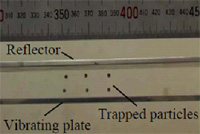Many areas of research and manufacturing require accurate ways of handling, transporting and assembling small objects such as electronic parts, micro mechanical components and tablets. It is best if this can be done without contacting the object during the production processes, to avoid contamination and damage.
However, conventional methods, such as levitating the objects using air jets, electro static or magnetic forces, are not always suitable for practical applications, because they often generate lots of dust, and voltages or magnetic fields can damage the object being transported.
Now, Daisuke Koyama and Kentaro Nakamura at Tokyo Institute of Technology have demonstrated a method of transporting small objects using ultrasound. Their method works by trapping the objects in the vertical direction at the nodal points of ultrasonic standing wave fields. The objects can then be moved in horizontal directions by controlling the phase of the ultrasonic field.
The devices consist of a vibration plate driven at two ends, and a reflector parallel to the vibrating plate. An intense ultrasonic standing field is excited between the plate and reflector.
The researchers achieved stable trapping of small particles just 2-3 mm in diameter at the nodal points between the vibrating plate and the reflector, and transported them in horizontal directions.
This simple ultrasonic vibration system allows the linear transportation of small objects without contacting or damaging the samples of interest. The researchers are now working to improve their system so that it can produce rotary motion, and transfer objects between two different transportation systems.
Reference
- Authors: Daisuke Koyama, and Kentaro Nakamura.
- Title of original paper: Noncontact ultrasonic transportation of small objects over long distances in air.
- Journal, volume, pages and year: IEEE Trans., Ferroelect., Freq. Contr., 57, 1152 (2010).
- Digital Object Identifier (DOI): 10.1109/TUFFC.2010.1527
- Affiliations: Precision and Intelligence Laboratory, Tokyo Institute of Technology.
- Department website: http://www.pi.titech.ac.jp/index-e.html


Small particles levitated between a vibrating plate and a reflector using ultrasound.
. Any information published on this site will be valid in relation to Science Tokyo.



